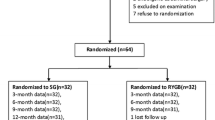Abstract
Background
The purpose of this study was to assess the effect of Roux-en-Y gastric bypass (RYGB) with different pouch size in Chinese type 2 diabetes mellitus (T2DM) patients with measured body mass index (BMI) 30–35 kg/m2.
Methods
In this randomized and prospective study, we evaluated the efficacy of RYGB with smaller size pouch (10–20 ml) versus larger pouch size (25–35 ml) in 76 Chinese obese patients (33 F, 43 M) with T2DM. According to protocol, all patients were divided into two groups, smaller pouch size group and larger pouch size group, and underwent RYGB surgery. Primary inclusion criteria of study were (a) a diagnosis of type 2 diabetes (glycated hemoglobin level >7.0 %), (b) measured BMI of at least 30 kg/m2 and not yet 35 kg/m2, and (c) age between 25 and 60 years old, and (d) patients were excluded if they had previously undergone complex abdominal surgery or bariatric surgery. Weight loss, BMI, percentage of excess weight loss (% EWL), glycated hemoglobin, and fasting plasma glucose were obtained at 3, 6, 9, and 12 months after surgery.
Results
Of these 76 patients, 69 (91 %) patients completed follow-up postoperative 12 months. Weight loss and % EWL at 12 months was greater in smaller pouch size group (mean 15.8 kg, 95 % CI −17.2 to −14.4 and mean 68.9, 95 % CI 62.5–75.2 %) than in larger pouch size group (mean −13.7 kg, 95 % CI −15.3 to −12.1, and mean 59.1, 95 % CI 52.8–65.5) (P = 0.046, P = 0.033, respectively). Glycemic control improved in both two groups, with a mean glycated hemoglobin level of 6.2 % (95 % CI 6.0–6.5 %) in smaller size group, and 6.7 % (95 % CI 6.4–7.0 %) in larger size group (P = 0.025, P < 0.05). The fasting plasma glucose level decreased significantly after surgery, with a mean level of 5.4 mmol/L (95 % CI 5.2–5.5 mmol/L) and 5.6 mmol/L (95 % CI 5.5–5.8 mmol/L) respectively, (P = 0.040, P < 0.05).
Conclusions
In this short-term study, in Chinese T2DM patients with BMI 30–35 kg/m2, we observed a greater efficiency on weight loss and glycemic control with smaller pouch size compared to larger pouch size. In the future, long-term follow-up and large sample study will be necessary to confirm these outcomes.


Similar content being viewed by others
References
Stoeckli R, Chanda Langer R. Changes of body weight and plasma ghrelin levels after gastric banding and gastric bypass. Obes Res. 2004;12:346–50.
Schauer PR, Kashyap SR, Wolski K, et al. Bariatric surgery versus intensive medical therapy in obese patients with diabetes. N Engl J Med. 2012;366(17):1567–76.
Freedman MR, King J, Kennedy E. Popular diets: a scientific review. Obes Res. 2001;9 Suppl 1:1S–40S.
Arterburn D. Bariatric surgery. BMJ. 2008;337:a755.
Buchwald H, Estok R, Fahrbach K, et al. Weight and type 2 diabetes after bariatric surgery: systematic review and meta-analysis. Am J Med. 2009;122(3):248.e5–56.e5.
Schauer PR, Burguera B, Ikramuddin S, et al. Effect of laparoscopic Roux-en Y gastric bypass on type 2 diabetes mellitus. Ann Surg. 2003;238:467–84.
Scopinaro N, Marinari GM, Camerini GB, et al. Specific effects of biliopancreatic diversion on the major components of metabolic syndrome: a long-term follow-up study. Diabetes Care. 2005;28:2406–11.
Sjostrom L, Lindroos AK, Peltonen M, et al. Lifestyle, diabetes, and cardiovascular risk factors 10 years after bariatric surgery. N Engl J Med. 2004;351:2683–93.
Pories WJ, Swanson MS, MacDonald KG, et al. Who would have thought it? An operation proves to be the most effective therapy for adult-onset diabetes mellitus. Ann Surg. 1995;222:339–50.
Roberts K, Duffy A, Kaufman J, et al. Size matters: gastric pouch size correlates with weight loss after laparoscopic Roux-en-Y gastric bypass. Surg Endosc. 2007;21:1397–402.
Lakdawala M, Bhasker A. Asian consensus meeting on metabolic surgery (ACMOMS) report: Asian consensus meeting on metabolic surgery. Recommendations for the use of bariatric and gastrointestinal metabolic surgery for treatment of obesity and type II diabetes mellitus in the Asian population: August 9th and 10th, 2008, Trivandrum, India. Obes Surg. 2010;20(7):929–36.
Kasama K, Mui W, Lee WJ, et al. IFSO-APC consensus statements 2011. Obes Surg. 2012;22(5):677–84.
David A, Andy B, Karen J, et al. Comparative effectiveness of bariatric surgery vs. nonsurgical treatment of type 2 diabetes among severely obese adults. Obes Res Clin Pract. 2013;7:e258–68.
E. Disse, A. Pasquer, P. Espalieu, et al. greater weight loss with the omega loop bypass compared to the Roux-en-Y gastric bypass: a comparative study. Obes Surg. 2014; 19. Published Online.
Buchwald H, Estok R, Fahrbach K, et al. Weight and type 2 diabetes after bariatric surgery: systematic review and meta-analysis. Am J Med. 2009;122(3):248–56.e5.
O'Connor EA, Carlin AM. Lack of correlation between variation in small-volume gastric pouch size and weight loss after laparoscopic Roux-en-Y gastric bypass. Surg Obes Relat Dis. 2008;4(3):399–403.
Isbell JM, Tamboli RA, Hansen EN, et al. The importance of caloric restriction in the early improvements in insulin sensitivity after Roux-en-Y gastric bypass surgery. Diabetes Care. 2010;33(7):1438–42.
Cummings DE, Weigle DS, Frayo RS, et al. Plasma ghrelin levels after diet-induced weight loss or gastric bypass surgery. N Engl J Med. 2002;346(21):1623–30.
Flanagan L. Measurement of functional pouch volume following the gastric bypass procedure. Obes Surg. 1996;6(1):38–43.
Nishie A, Brown B, Barloon T, et al. Comparison of size of proximal gastric pouch and short-term weight loss following routine upper gastrointestinal contrast study after laparoscopic Roux-en-Y gastric bypass. Obes Surg. 2007;17(9):1183–8.
Conflict of Interest
We declare that we have no conflict of interest.
Author information
Authors and Affiliations
Corresponding author
Rights and permissions
About this article
Cite this article
Ren, Y., Yang, W., Yang, J. et al. Effect of Roux-en-Y Gastric Bypass with Different Pouch Size in Chinese T2DM Patients with BMI 30–35 kg/m2 . OBES SURG 25, 457–463 (2015). https://doi.org/10.1007/s11695-014-1411-y
Published:
Issue Date:
DOI: https://doi.org/10.1007/s11695-014-1411-y




